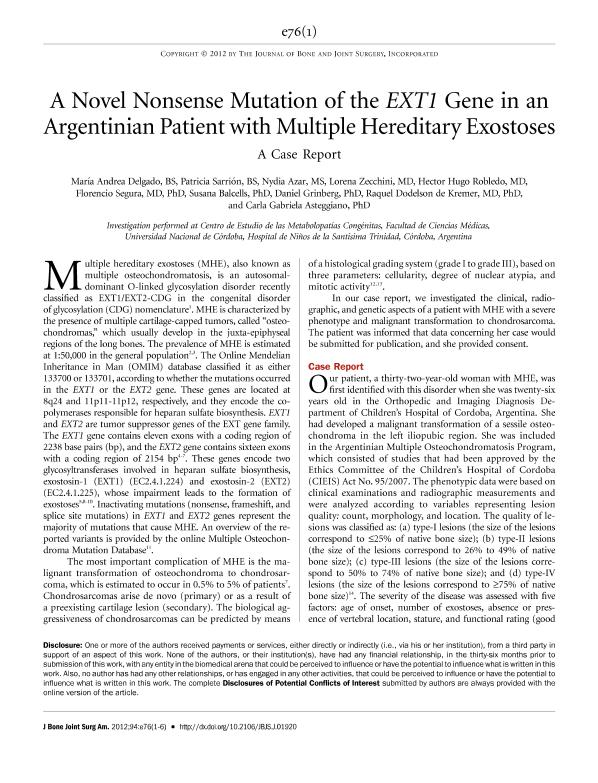Mostrar el registro sencillo del ítem
dc.contributor.author
Delgado, María Andrea

dc.contributor.author
Sarrión, Patricia
dc.contributor.author
Azar, Nydia Beatríz

dc.contributor.author
Zecchini, Lorena del Valle

dc.contributor.author
Robledo, Hector Hugo

dc.contributor.author
Segura, Florencio Vicente

dc.contributor.author
Balcells, Susana
dc.contributor.author
Grinberg Vaisman, Daniel Raúl

dc.contributor.author
Dodelson de Kremer, Raquel

dc.contributor.author
Asteggiano, Carla Gabriela

dc.date.available
2023-05-18T13:47:14Z
dc.date.issued
2012-06
dc.identifier.citation
Delgado, María Andrea; Sarrión, Patricia; Azar, Nydia Beatríz; Zecchini, Lorena del Valle; Robledo, Hector Hugo; et al.; A novel nonsense mutation of EXT1 gene in an Argentinian patient with Multiple Hereditary Exostoses; Journal Bone Joint Surgery Inc; Journal Of Bone And Joint Surgery-american Volume; 94; 11; 6-2012; 761-766
dc.identifier.issn
0375-9229
dc.identifier.uri
http://hdl.handle.net/11336/197999
dc.description.abstract
Multiple hereditary exostoses (MHE), also known as multiple osteochondromatosis, is an autosomal-dominant O-linked glycosylation disorder recently classified as EXT1/EXT2-CDG in the congenital disorder of glycosylation (CDG)nomenclature. MHE is characterized by the presence of multiple cartilage-capped tumors,called “osteochondromas,” which usually develop in the juxta-epiphyseal regions of the long bones. The prevalence of MHE is estimated at 1:50,000 in the general population1,2. The Online Mendelian Inheritance in Man (OMIM) database classified it as either 133700 or 133701, according to whether the mutations occurred in the EXT1 or the EXT2 gene. These genes are located at 8q24 and 11p11-11p12, respectively, and they encode the copolymerases responsible for heparan sulfate biosynthesis. EXT1 and EXT2 are tumor suppressor genes of the EXT gene family. The EXT1 gene contains eleven exons with a coding region of 2238 base pairs (bp), and the EXT2 gene contains sixteen exons with a coding region of 2154 bp3-6. These genes encode two glycosyltransferases involved in heparan sulphate biosynthesis, exostosin-1 (EXT1) (EC2.4.1.224)and exostosin-2 (EXT2) (EC2.4.1.225), whose impairment leads to the formation of exostoses4,7-9. Inactivating mutations (nonsense, frameshift, and splice site mutations) in EXT1 and EXT2 genes represent the majority of mutations that cause MHE. An overview of the reported variants is provided by the online Multiple Osteochondroma Mutation Database10. The most important complication of MHE is the malignant transformation of osteochondroma to chondrosarcoma, which is estimated to occur in 0.5% to 5% of patients6. Chondrosarcomas arise de novo (primary) or as a result of a preexistingcartilage lesion (secondary). The biological aggressiveness of chondrosarcomas can be predicted by means of a histological grading system (grade I to grade III), based on three parameters: cellularity, degree of nuclear atypia, and mitotic activity11,12.In our case report, we investigated the clinical, radiographic, and genetic aspects of a patient with MHE with a severe phenotype and malignant transformation to chondrosarcoma.
dc.format
application/pdf
dc.language.iso
eng
dc.publisher
Journal Bone Joint Surgery Inc

dc.rights
info:eu-repo/semantics/openAccess
dc.rights.uri
https://creativecommons.org/licenses/by-nc-sa/2.5/ar/
dc.subject
Multiple Osteochondromatosis
dc.subject
O-glycosylation
dc.subject
EXT1/EXT2-CDG
dc.subject.classification
Otras Ciencias Médicas

dc.subject.classification
Otras Ciencias Médicas

dc.subject.classification
CIENCIAS MÉDICAS Y DE LA SALUD

dc.title
A novel nonsense mutation of EXT1 gene in an Argentinian patient with Multiple Hereditary Exostoses
dc.type
info:eu-repo/semantics/article
dc.type
info:ar-repo/semantics/artículo
dc.type
info:eu-repo/semantics/publishedVersion
dc.date.updated
2023-05-12T10:09:48Z
dc.identifier.eissn
0021-9355
dc.journal.volume
94
dc.journal.number
11
dc.journal.pagination
761-766
dc.journal.pais
Estados Unidos

dc.description.fil
Fil: Delgado, María Andrea. Gobierno de la Provincia de Córdoba. Ministerio de Salud. Hospital de Niños de la Santísima Trinidad; Argentina
dc.description.fil
Fil: Sarrión, Patricia. Universidad de Barcelona; España
dc.description.fil
Fil: Azar, Nydia Beatríz. Gobierno de la Provincia de Córdoba. Ministerio de Salud. Hospital de Niños de la Santísima Trinidad; Argentina
dc.description.fil
Fil: Zecchini, Lorena del Valle. Gobierno de la Provincia de Córdoba. Ministerio de Salud. Hospital de Niños de la Santísima Trinidad; Argentina
dc.description.fil
Fil: Robledo, Hector Hugo. Gobierno de la Provincia de Córdoba. Ministerio de Salud. Hospital de Niños de la Santísima Trinidad; Argentina
dc.description.fil
Fil: Segura, Florencio Vicente. Gobierno de la Provincia de Córdoba. Ministerio de Salud. Hospital de Niños de la Santísima Trinidad; Argentina
dc.description.fil
Fil: Balcells, Susana. Universidad de Barcelona; España
dc.description.fil
Fil: Grinberg Vaisman, Daniel Raúl. Universidad de Barcelona; España
dc.description.fil
Fil: Dodelson de Kremer, Raquel. Gobierno de la Provincia de Córdoba. Ministerio de Salud. Hospital de Niños de la Santísima Trinidad; Argentina
dc.description.fil
Fil: Asteggiano, Carla Gabriela. Gobierno de la Provincia de Córdoba. Ministerio de Salud. Hospital de Niños de la Santísima Trinidad; Argentina. Consejo Nacional de Investigaciones Científicas y Técnicas; Argentina. Universidad Nacional de Córdoba; Argentina. Universidad Católica de Córdoba; Argentina
dc.journal.title
Journal Of Bone And Joint Surgery-american Volume

dc.relation.alternativeid
info:eu-repo/semantics/altIdentifier/doi/http://dx.doi.org/10.2106/JBJS.J.01920
dc.relation.alternativeid
info:eu-repo/semantics/altIdentifier/url/https://journals.lww.com/jbjsjournal/Citation/2012/06060/A_Novel_Nonsense_Mutation_of_the_EXT1_Gene_in_an.15.aspx
Archivos asociados
